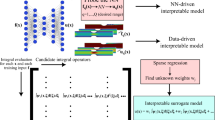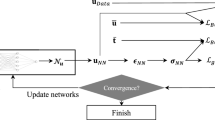The paper discusses how to verify the quality of approximate solutions to partial differential equations constructed by deep neural networks. A posterior error estimates of the functional type, that have been developed for a wide range of boundary value problems, are used to solve this problem. It is shown, that they allow one to construct guaranteed two-sided estimates of global errors and get distribution of local errors over the domain. Results of numerical experiments are presented for elliptic boundary value problems. They show that the estimates provide much more reliable information on the quality of approximate solutions generated by networks than the loss function, which is used as a quality criterion in the Deep Galerkin method.
Similar content being viewed by others
References
W. E. J. Han and A. Jentzen, “Deep learning-based numerical methods for highdimensional parabolic partial differential equations and backward stochastic differential equations,” Commun. Math. Stat., 5, 349–380 (2017).
J. He, L. Li, J. Xu, and C. Zheng, “ReLU deep neural networks and linear finite elements,” arXiv:1807.03973v2, arXiv (2018).
R. Khudorozhkov, S. Tsimfer, and A. Koryagin, “PyDEns framework for solving differential equations with deep learning,” arXiv:1909.11544 [cs.LG], arXiv (2019).
I. E. Lagaris, A. Likas, and D. I. Fotiadis, “Artificial neural networks for solving ordinary and partial differential equations,” IEEE Transactions on Neural Networks 9, No. 5, 987–1000 (1997).
W. E and B. Yu, “The Deep Ritz Method: A deep learning-based numerical algorithm for solving variational problems,” Commun. Math. Stat., 6, 1–12 (2018).
O. Pironneau, “Parameter identification of a fluid-structure system by deep-learning with an Eulerian formulation,” Methods Appl. Anal., 26, No. 3, 281–290 (2019).
F. Regazzonia, L. Dede, and A. Quarteroni, “Machine learning for fast and reliable solution of time-dependent differential equations,” J. Comput. Phys., 397 , 108852 (2019).
E. Samaniego, C. Anitescu, S. Goswami, V. M. Nguyen-Thanh, H. Guo, K. Hamdia, X. Zhuang, and T. Rabczuka, “An energy approach to the solution of partial differential equations in computational mechanics via machine learning: Concepts, implementation and applications,” Comput. Methods Appl. Mech. Engrg., 362, 112790 (2020).
S. Repin, A Posteriori Estimates for Partial Differential Equations, Walter de Gruyter GmbH & Co. KG, Berlin (2008).
R. Verfürth, A Review of A Posteriori Error Estimation and Adaptive Mesh-Refinement Techniques, Wiley-Teubner, Stuttgart (1996).
S. Repin, “A posteriori error estimation for nonlinear variational problems by duality theory,” Zap. Nauchn. Semin. POMI, 243, 201–214 (1997); English transl. J. Math. Sci. 99, No. 1 (2000).
S. Repin, “A posteriori error estimation for variational problems with uniformly convex functionals,” Math. Comp., 69 (230), 481–500 (2000).
S. Repin, “Two-sided estimates of deviation from exact solutions of uniformly elliptic equations,” Amer. Math. Soc. Transl., 209, 143–171 (2003).
S. Repin, “Estimates of deviation from exact solutions of initial-boundary value problems for the heat equation,” Rend. Mat. Acc. Lincei., 13, 121–133 (2002).
S. Repin, S. Sauter, and A. Smolianski, “Two-sided a posteriori error estimates for mixed formulations of elliptic problems,” SIAM J. Num. Anal., 45, 928–945 (2007).
S. Repin and M. Frolov, “A posteriori error estimates for approximate solutions of elliptic boundary value problems,” Zh. Vychisl. Mat. Mat. Fiz., 42, No. 12, 1704–1716 (2002).
O. Mali, P. Nettaanmäki, and S. Repin, Accuracy Verification Methods. Theory and Algorithms, Springer, Berlin (2014).
Author information
Authors and Affiliations
Corresponding author
Additional information
Translated from Zapiski Nauchnykh Seminarov POMI, Vol. 499, 2021, pp. 77–104.
Rights and permissions
Springer Nature or its licensor (e.g. a society or other partner) holds exclusive rights to this article under a publishing agreement with the author(s) or other rightsholder(s); author self-archiving of the accepted manuscript version of this article is solely governed by the terms of such publishing agreement and applicable law.
About this article
Cite this article
Muzalevskiy, A.V., Repin, S.I. A Posteriori Error Control of Approximate Solutions to Boundary Value Problems Found by Neural Networks. J Math Sci 273, 492–510 (2023). https://doi.org/10.1007/s10958-023-06516-9
Received:
Published:
Issue Date:
DOI: https://doi.org/10.1007/s10958-023-06516-9




